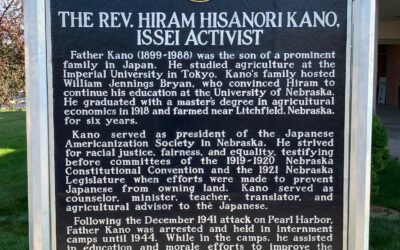Nebraska has an almost uninterrupted fossil record of the past thirty-five million years, roughly half the time since dinosaurs became extinct. Fossilized remains of prehistoric plants and animals have been discovered in the state’s soil and sedimentary rock since territorial days. The Nebraska Farmer of November 1860 included a brief article by editor Robert W. Furnas on a recent find in Nebraska Territory. Entitled “A Monster’s Bone,” the piece indicates Furnas’s interest in the prehistory as well as the history of Nebraska.
“We were this week presented by Mr. I. N. Kelly with a huge bone,” wrote Furnas, “and also a tooth of some monstrous animal that lived and flourished ‘long, long ago.’ They were found on the plains, about one hundred and fifty miles west of this place [Brownville]. The bone is undoubtedly a portion of one of the leg bones; measures 26 inches in circumference and is very much decayed. The tooth, too is decayed to considerable extent.
“Mr. Kelly states that while on a Buffalo hunt his attention was attracted to a large display of white substance in the distance which resembled a lime kiln. –On arriving at the spot he found on the surface, about a wagon load of decayed bones, evidently once the frame work of a single animal. They were at the head of a gulch or ravine, and had probably been exhumed to some extent by the streams formed by heavy rains. From appearances there yet remains below the surface more of the monster’s bones than were seen above.
“We are not a sufficiently practical naturalist to venture a dissertation upon this discovery; but have no hesitancy, after an examination, particularly of the tooth, in pronouncing the remains to be that of an animal belonging to one of the largest terrestrial Mammalia and of the order Herbivora.
“We understand some two years ago the bones of a Magatherium were discovered somewhere in the interior west of us. We know not whether a scientific examination was made or not; and it may be the bones found by Mr. Kelly are the same.”
Furnas, whose scientific curiosity had been aroused by the find, concluded, “Had we time to spare, we would visit the spot, [and] may do so next spring.”



